Abstract
Podcasts are a digital technology that librarians and historians can leverage to share content from their archival collections with users who may not otherwise have access. In addition to the preservation and dissemination of oral history transcripts and audio files within a library collection, this pilot research project added a novel outreach dimension through podcasting. Unedited oral history audio of rock climbers and mountaineers from two digital library collections were published to a podcast, Ascent Archive. This study evaluates whether people would listen to full-length oral history interviews and if the podcast would increase access to the corresponding digital library item and the entire oral history collection. Usage data from Simplecast, the chosen podcast hosting, distribution, and analytics platform, and the University of Utah’s (USA) digital library were analyzed. The Ascent Archive podcast had over 1,670 downloads with over 815 unique listeners from around the world, with 90 % in the United States. The Simplecast and digital library analytics data suggest that a podcast episode increases use of the corresponding digital library item but not the remainder of the collection. This is the first study to investigate and analyze the data from both a podcast and corresponding digital library collections. This study demonstrates a new outreach strategy to expand access to oral histories while meeting modern listening expectations.
1 Introduction
Podcast listenership worldwide has almost doubled in the last six years with an estimated 504.9 million listeners in 2024 alone (Statista 2024). In 2023, about half of Americans had listened to podcasts within the past year and “one-in-five of those listeners say they listen to a podcast nearly every day” (Shearer et al. 2023, n.p.). People are turning to podcasts for entertainment, learning, and diversion (listening while doing another activity) with the topics of comedy, entertainment, and politics being the most popular (Shearer et al. 2023). According to Drew (2017), many educational podcasts fall into the three genres of quick burst (<5 min), narrative (40–80 min of storytelling), and chat show (“witty dialogue”). This aligns with the Pew Research Center’s finding that the top-ranked podcasts use a variety of formats: “38 % feature deep reporting or explain a topic, roughly a quarter (23 %) are interview shows, and 16 % are based around commentary” (Stocking et al. 2023, n.p.). The podcast industry has substantially grown with new commercial and advertising offerings (Steele 2024). Podcasters offer their paid subscribers access to ad-free listening, extra behind-the-scenes episodes, and other incentives (Steele 2024).
Podcasts are also popular in higher education settings. Professors develop active learning assignments where students interview others and produce podcasts (Tait and Schriner 2022). For example, My Story, My Voice is a “student-produced, community-engaged diversity podcast for a Diversity & Media (Journalism) course,” where Ball State University’s students interview local community members (Tait and Schriner 2022, 206). Another podcast example from the University of Southern Florida is Calling: Earth (Smith et al 2020), a collaboration between the Geosciences department and library to share Geosciences’ faculty and student research through 30–60 min interviews (Smith et al 2020). These two podcast examples highlight how higher education institutions leverage podcasts to fulfill their education and research missions.
Academic libraries and archives primarily leverage podcasts to share information about their spaces, resources, and services (Bierman and Valentino 2011; De Sarkar 2012). Bierman and Valentino’s (2011) work found that 37 of the 112 Association of Research Libraries (ARL) member research libraries have podcasting initiatives. The ARL libraries’ podcast content primarily focused on using library resources, followed by recorded lectures and events, and then tours (Bierman and Valentino 2011). An international analysis of academic and public libraries by De Sarkar (2012) found that most library podcast content contains information for library orientation tours and guidance on using library resources and facilities (De Sarkar 2012). More recently, Story’s (2022) editorial article advocated for podcast spaces, equipment, and library-generated podcasts. Specifically, the University of California at Santa Cruz library provides physical spaces, equipment, and software for recording and editing podcasts (Story 2022). Additionally, they offer recording equipment that can be checked out and workshops to teach students about podcast-related skills (Story 2022). Story and colleagues created Stories from the Epicenter, a 10-episode podcast series documenting the experience and memory of the 1989 Loma Prieta earthquake to align with its thirtieth anniversary (Story 2022).
Podcasts focusing on history typically leverage edited excerpts of oral history audio and other primary source archival materials. Oral histories give “voice to people not included in the usual historical sources, oral history can provide a fuller, more honest picture of the past by answering the hows and whys of human action” (Mercier and Buckendorf 2010, ii). For example, Case Western Reserve Libraries’ podcast Case Stories provides audio from interviews of prominent university figures (Bierman and Valentino 2011). The Queens Memory and Mississippi Moments podcasts include oral history excerpts with contextual and historical commentary to share the local history of Queens, New York, and Mississippi respectively (Bartolini 2022; Little 2022). Another historical podcast, Campu, focuses on Japanese Americans’ concentration camp experiences during World War II, the community’s continued trauma, and anti-Asian racism experiences (Yoshida 2021). Campu includes excerpts from Densho’s oral histories, California State University’s collections of scholars, and American concentration camp descendants, in addition to modern narrators’ stories (Yoshida 2021). The place-based podcast, Cork is the Lee, presents the role of a river in the life of a region by using field recordings, oral history interviews, and other historical sources (Scriven 2022). The Museum of South Texas History’s podcast, Stories from the Rio Grande, presents the local history of the region featuring their collections and interviews with locals (Morales De Hendricks 2022). Finally, To The Letter is a library-created podcast about an archival collection of letters (Rupinski and Rander 2019). It includes dramatic readings of the letters between two lovers and narrators to provide historical context based on an unpublished autobiography and general history from that period.
At the University of Utah’s J. Willard Marriott Library (Marriott Library), our standard practice for disseminating oral histories is to provide the transcript text online. If there is a corresponding audio recording for a transcript, this must be requested separately. At the Marriott Library only newer digital library collections contain audio files with the transcripts. Audio files from most collections must be requested from Special Collections. Due to changes within audio recording technology, the older oral histories typically contain multiple audio files that must be combined manually to listen to the entire full-length interview. With the advent of podcasts and modern audio listening options, we hypothesized that a podcast would meet modern users’ expectations for listening to audio online. With this in mind, the aim of this research is to determine if podcasting archival content, specifically full-length oral histories, can be a novel outreach opportunity for other libraries and collections. The research questions are.
Will people listen to a podcast of unedited full-length oral history audio files?
Does a podcast episode increase the use of the corresponding digital library item?
Does a podcast of select oral histories benefit their entire collection in the digital library?
In this study, we published unedited full-length audio recordings from oral histories with rock climbers and mountaineers on a library-created podcast, Ascent Archive. We chose rock climbing as a podcast topic because of its regional and cultural significance (Salt Lake Climbers Alliance n.d.) and existing relevant collections at the Marriott Library. At the Marriott Library, there are five collections of oral histories of rock climbers. The Ascent Archive episodes were drawn from two of the five oral history collections (Image 1: Timeline). The other three collections were excluded from this study due to poor audio quality and no agreement paperwork about publishing the content online by the interviewee or interviewer. Two of these collections’ transcripts and some audio are in the digital library for worldwide access. The largest collection is the Everett L. Cooley Oral History Project (ELC) which spans over three decades of oral histories conducted by the American West Center (J. Willard Marriott Library n.d.b). The ELC includes approximately 80 interviews with rock climbers and mountaineers, conducted from 2006 to 2011. In 2023 a new collection, the Rock Climbers Oral History Project (RCOHP), was added to the digital library (J. Willard Marriott Library n.d.d). The RCOHP collection contains 35 interviews with both transcripts and audio files.
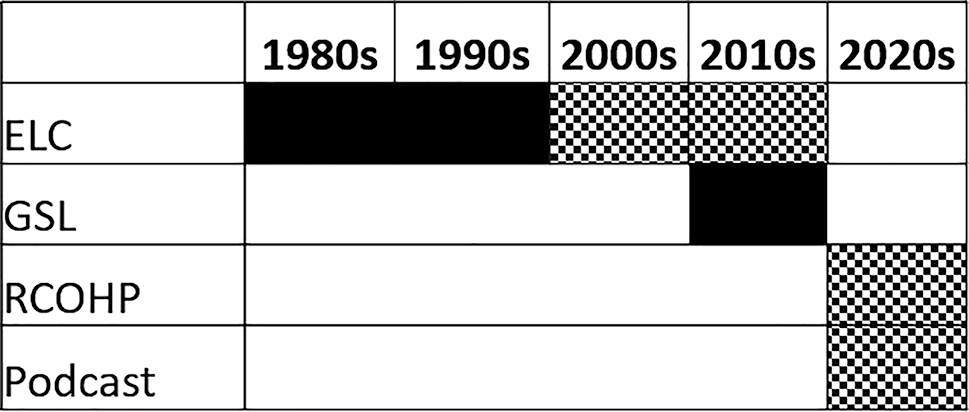
Decade-based timeline of when the oral history interviews were conducted and Ascent Archive podcast was created. The checkered boxes indicate the podcast content from both ELC and RCOHP collections. Early ELC and GSL interviews are not on Ascent Archive.
In addition to the ELC and RCOHP, another Digital Library collection of oral histories, Great Salt Lake Oral History Collection (GSL), was used in the analyses (J. Willard Marriott Library n.d.c). The GSL collection was a collection of oral histories from 2013 to 2015 with prominent environmental advocates focused on their experiences with the Great Salt Lake, a natural feature at risk of collapsing. Its regional focus, collection size, creation, and publication timeline is closer to the creation of the RCOHP, therefore this collection’s usage analytics were selected to serve as a baseline example of a digital library oral history collection without a podcast counterpart. The GSL collection within the digital library includes transcripts and some audio.
2 Methods
The Ascent Archive podcast’s pre-recorded and reused introduction and ending segments and episode-specific introductions were recorded using a Zoom H6 Handheld recorder. Musical transitions were secured from a library colleague and musician. Using available university resources, the audio editing software Adobe Audition 2024 was used to perform audio quality enhancements and combine segments of pre-recorded intros, the outro, music interludes, and Ascent Archive oral history audio to create each podcast episode. The ELC oral histories were recorded more than a decade ago for transcription purposes, and thus ELC required more audio quality enhancements due to poor audio quality and background noises. The library’s web developer and graphic designer created a podcast thumbnail (Image 2) and WordPress website (J. Willard Marriott Library n.d.a) that included information about the podcast and the RSS feed. An annual subscription to Simplecast (Simplecast n.d.) was purchased, which creates an RSS feed and publishes the podcast to multiple platforms (e.g. Apple Podcasts, Spotify), in addition to collecting more detailed analytics. Within the show notes, each episode includes a brief text summary and a link to the full transcript within the digital library.
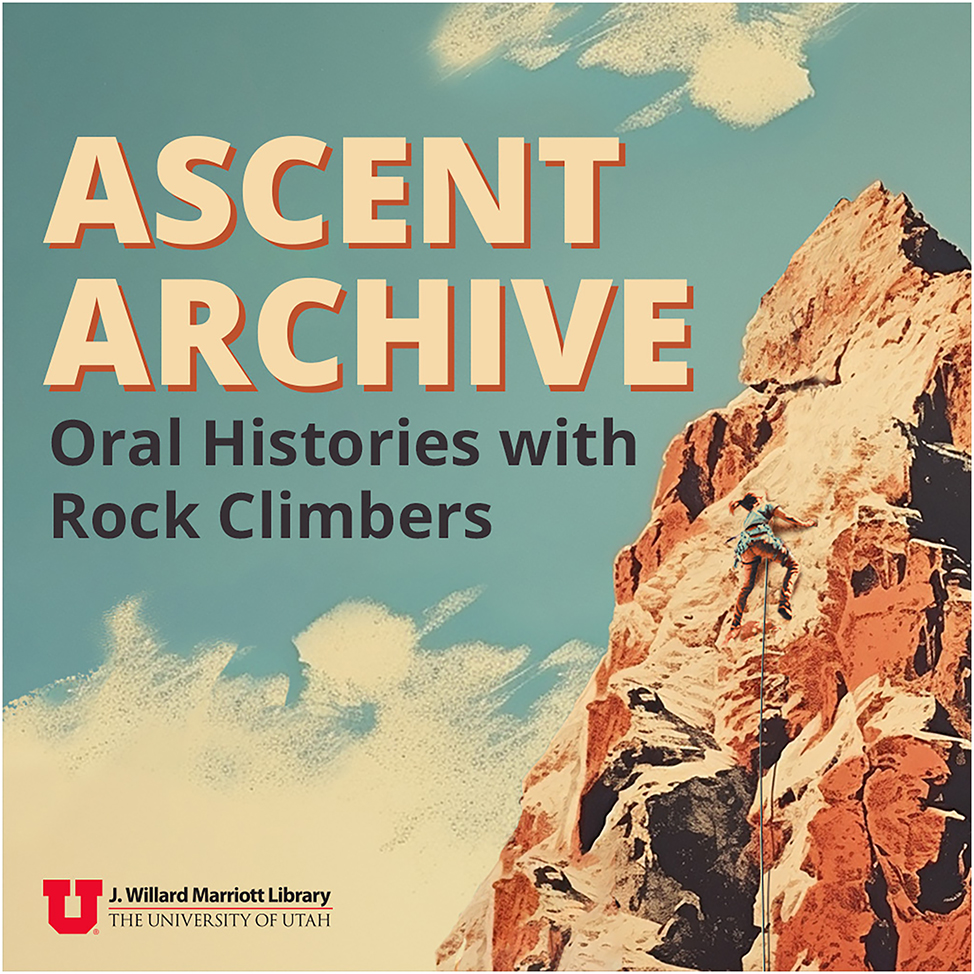
Thumbnail for Ascent Archive podcast.
The podcast was advertised via the Marriott Library and the university’s newsletters and social media. The podcast hosts shared information about Ascent Archive through personal social media and professional conference presentations. Finally, the local climbing non-profit shared Ascent Archive through their outreach channels.
Usage data from Simplecast and Digital Library informed the analyses. Both sources provided date and time, views or downloads (hits), and geographical location based on IP addresses. Additionally, Simplecast provided data on the listening method, listening device, and playback speed. Digital library datasets were exported on October 4, 2024 and Simplecast datasets were exported on January 11, 2025. Digital Library datasets contain raw, un-summarized data and ranged from ∼6,000 to 38,000 rows of data, whereas the Simplecast dataset contains summarized data, resulting in only 38 rows of data. For consistency, this study analyzes analytics in the date range of January 1, 2023 to September 30, 2024, unless stated otherwise. The spelling of individual’s names was compared between datasets and any differences (e.g., “n” vs “ñ” or inclusion of a nickname “first-name last-name” versus “first-name “nick-name” last-name”) were resolved to facilitate systematic comparisons between datasets. Data analyses were performed using R and RStudio. To preserve patron and listener privacy, we do not report geographical location data.
3 Results
The Ascent Archive podcast was launched on July 21, 2023 with weekly episodes released each Tuesday until April 9, 2024, and reached 38 episodes (Table 1). Two oral histories with audio lasting more than 2 h were separated into multi-part episodes, with each part delineated in the title (e.g. Part 1 of 2). To create weekly episodes for the Ascent Archive, mixing and editing audio segments took one to 3 h a week. Despite an efficient workflow, the older audio from ELC required more audio enhancements and reviewing, which added to the estimated time needed for podcast production.
Ascent Archive episodes and individuals represented from the ELC and RCOHP digital library collections.
| Digital library collections on the Ascent Archive | ELC (n) | RCOHP (n) | Total (n) |
|---|---|---|---|
| Episodes | 16 | 22 | 38 |
| Individuals | 10 | 22 | 32 |
To address research question 1 – Will people listen to a podcast of unedited full-length oral history audio files? – we reviewed Simplecast metrics and conducted additional analyses using the raw data. According to Simplecast’s analytics, as of June 24, 2025, the Ascent Archive podcast has over 1,670 downloads with over 815 unique listeners from around the world with 90 % in the United States. The most popular listening methods are Apple Podcasts (70%) and Spotify (20 %); the most popular listening devices are desktop (66 %), followed by phone (26 %); 95 % of listeners listened at 1.0× speed.
The Simplecast raw data indicates that people will listen to unedited oral history audio files on a podcast. We further investigated the podcasts’ monthly downloads and podcast release dates to see how people interacted with the episodes over time. The Ascent Archive podcast total downloads vary month-to-month with a medium of 62 downloads per month from July 21, 2023 to December 31, 2024 (Figure 1). Despite not releasing any new episodes since April 2024 (Figure 1, blue line), the podcast continues to be downloaded (Figure 1, gray bars). The medium number of downloads during active weekly episode releases (July 2023–April 2024) was higher than during our inactive period of the study (May 2024–December 2024), 73 and 58 respectively. The earlier podcast episodes have more total downloads (Figure 2), which suggests that most listeners start listening to the earlier podcast episode releases. The outlier with 63 downloads is the first of a six part series with an internationally famous mountaineer. The other podcast episodes with above-average download numbers since release are mostly climbers who are also authors or videographers.
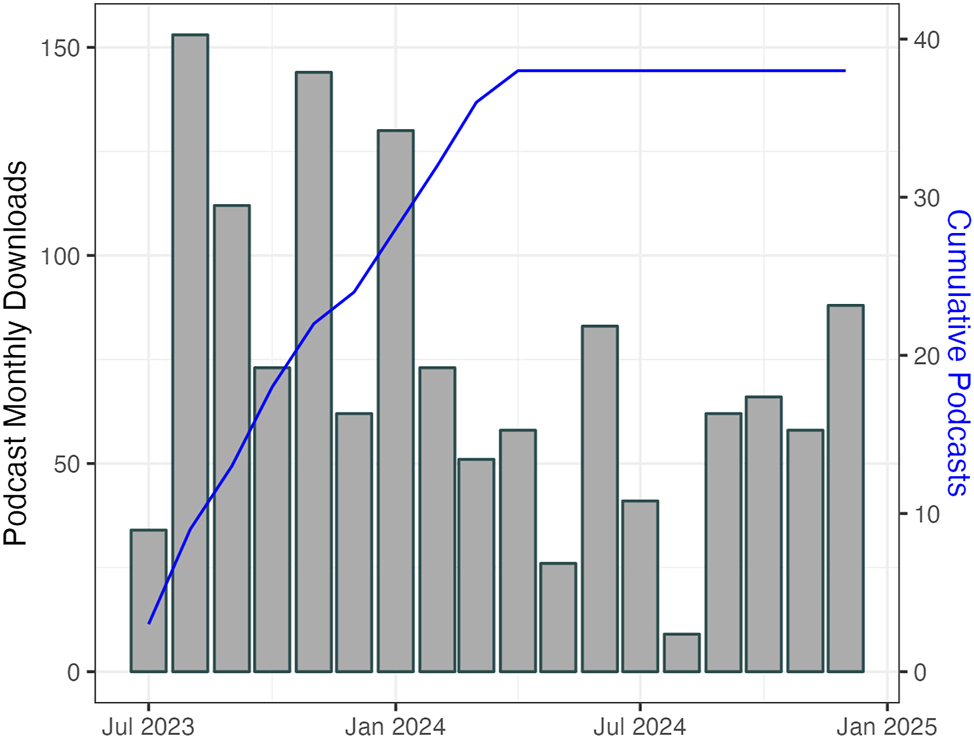
Monthly podcast downloads and cumulative podcasts released. The total number of podcast downloads are shown for each month (grey bars), along with the cumulative number of podcasts that were released (blue line).
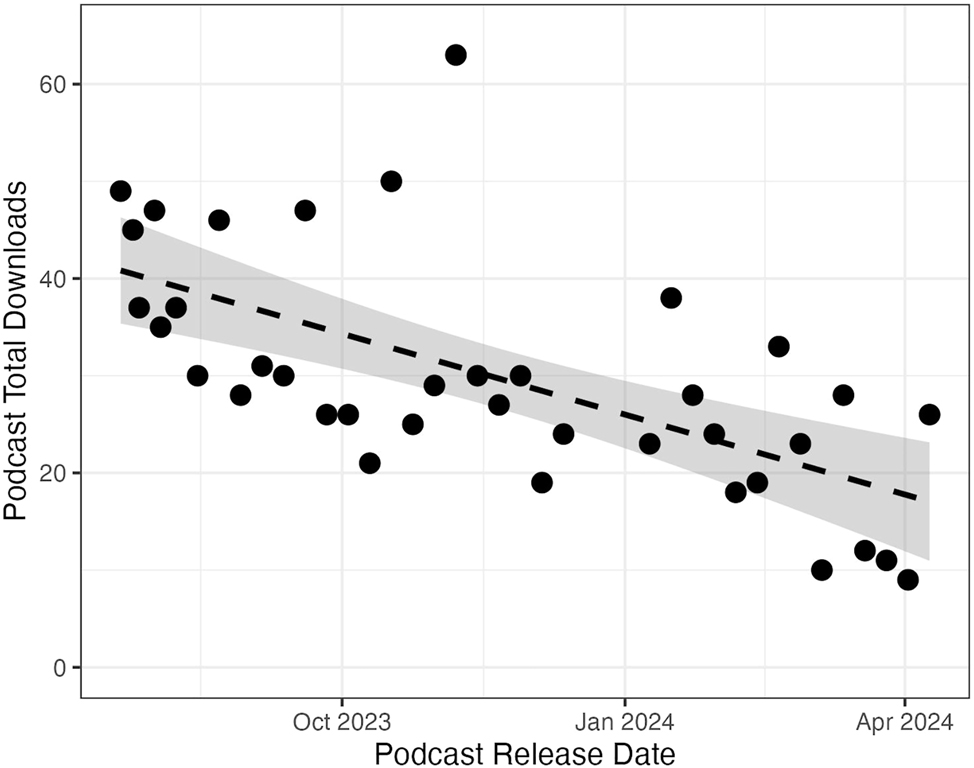
Podcast downloads by release date for all 38 podcast episodes of the Ascent Archive podcast series. The dashed line is the best fit linear regression, which models the relationship between the two variables being compared (i.e., podcast total downloads vs podcast release date). The shaded grey area represents the 95 % confidence interval of the linear regression. Total downloads as of December 31, 2024.
Before addressing whether podcasts affect the associated digital library collection (research questions 2 and 3), we reviewed the historical monthly views of the three collections within the digital library (Figure 3). By utilizing the digital library IP address data, both a total and “unique” number of views can be created for collections (Figure 3). Unique views were defined as unique combinations of the IP address and item within a given month. This indicates that people sometimes re-visit the transcript or there are multiple viewers accessing content from a common IP address. Figure 3 shows the total monthly views for the ELC, GSL, and RCOHP collections within the digital library from January 2023 to September 2024. The total and unique views generally follow a similar trend, suggesting that we can use either for subsequent analyses.
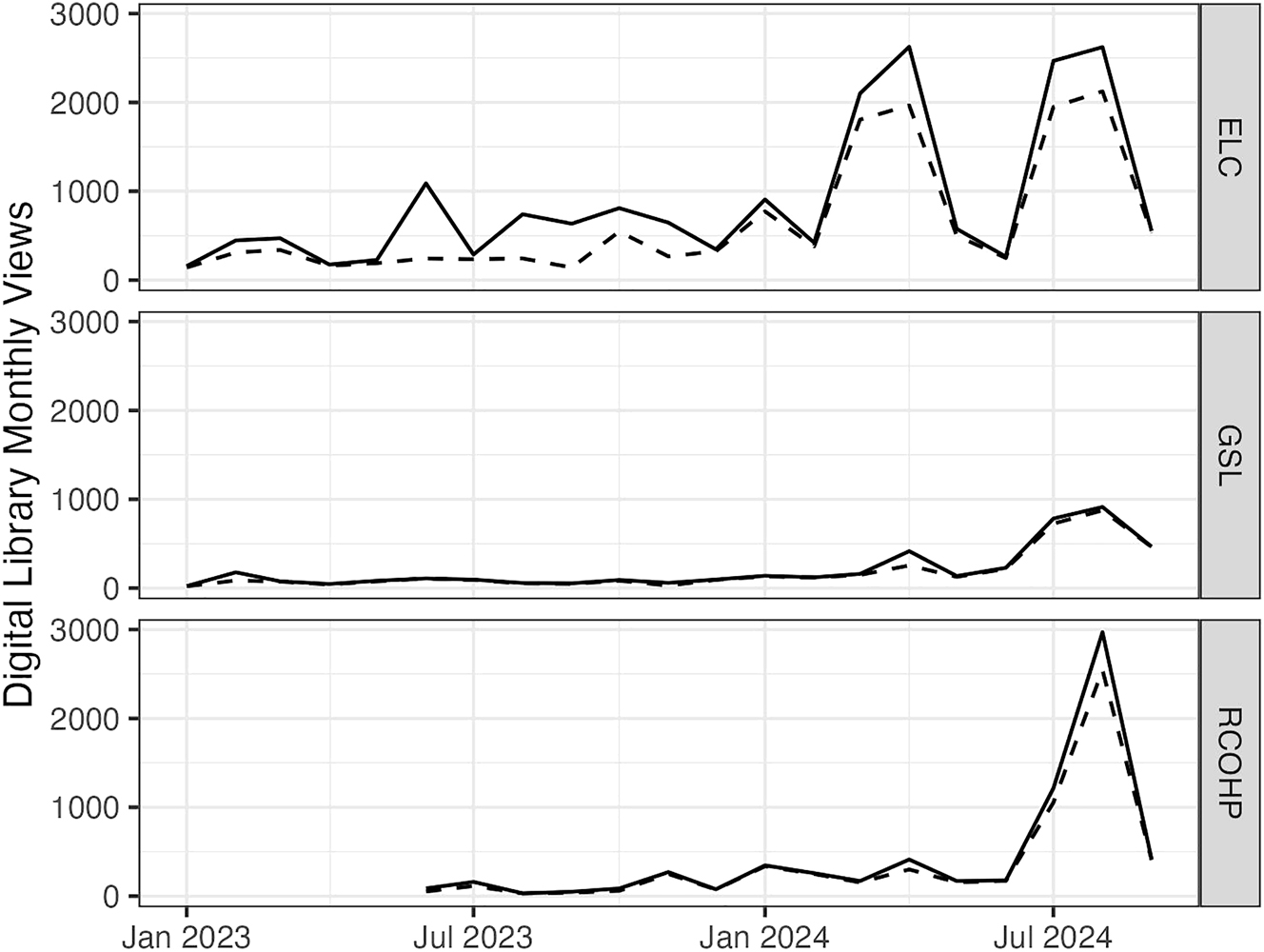
Total (solid) and unique (dashed) monthly views for three digital library collections. Digital library oral history collection abbreviations: ELC = Everett L. Cooley Oral History Project; GSL = Great Salt Lake Oral History Collection; RCOHP = Rock Climbing Oral History Project.
To assess research questions 2 and 3 – Does a podcast episode increase the use of the corresponding Digital Library item?; Does a podcast of select oral histories benefit their entire collection in the Digital Library? – we performed analyses using the combined podcast and digital library datasets (Figures 4 and 5). The total views over the observation period for the digital library collections were assessed as a function of whether the oral history had a podcast released or not (Table 2 and Figure 4). The median number of total views was slightly higher for oral histories that also had a podcast episode (green boxes). This trend was more apparent in the RCOHP collection compared with the ELC collection, though neither was statistically significant (Wilcoxon Rank-Sum test, p-values = 0.18 and 0.34, respectively). These analyses suggest that a podcast episode increases the use of the corresponding digital library item. When comparing digital library views of items without a podcast component (red boxes) between collections, there is essentially no difference in the number of total views. The GSL serves as a baseline example of a digital library oral history collection without a podcast counterpart. These analyses suggest that a podcast of select oral histories does not benefit the remainder of the collection in the digital library, since non-podcast RCOHP views are consistent with GSL views.
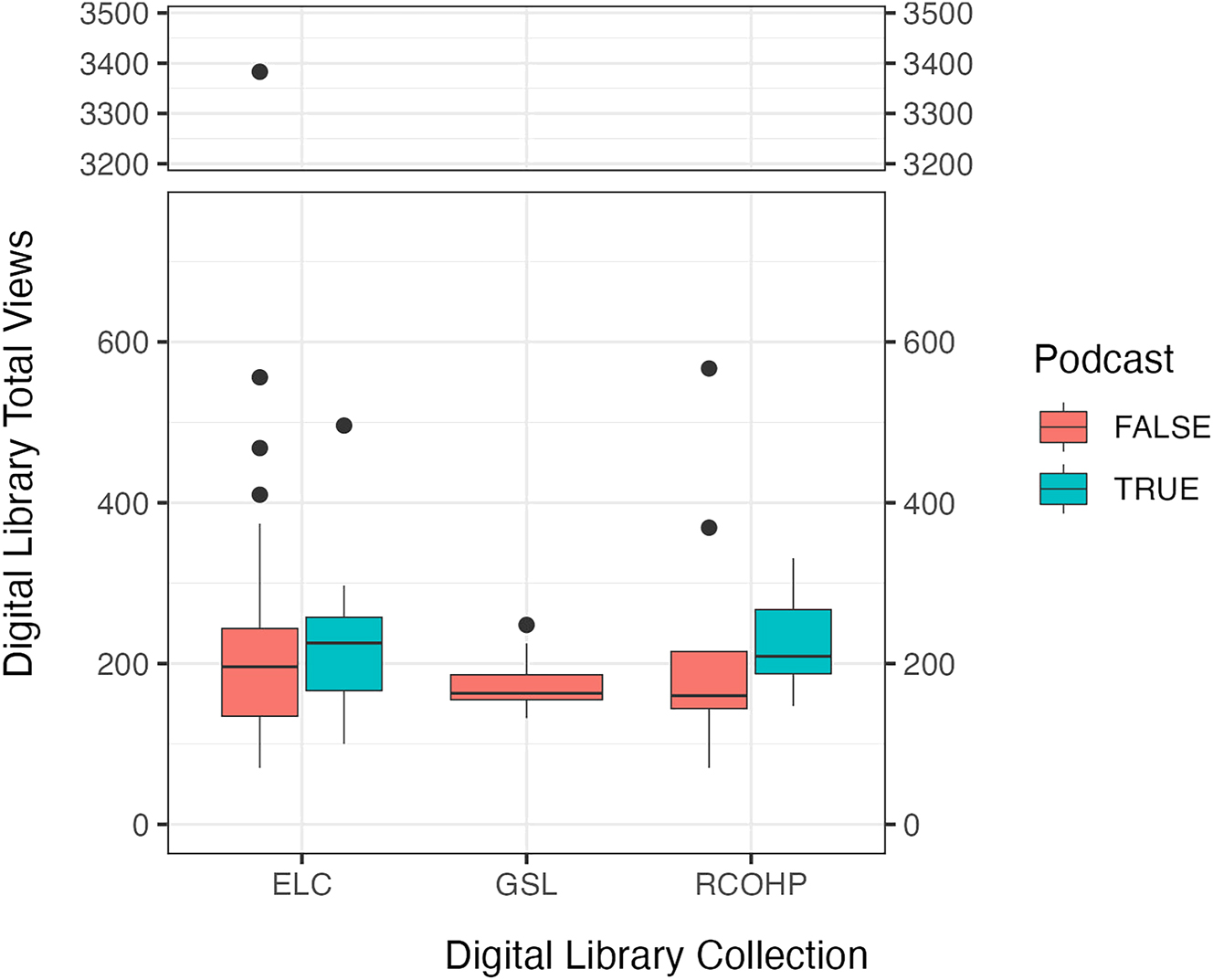
Boxplot of total digital library views separated by those with and without podcast episodes. Digital Library collection abbreviations: ELC = Everett L. Cooley Oral History Project; GSL = Great Salt Lake Oral History Collection; RCOHP = Rock Climbing Oral History Project.
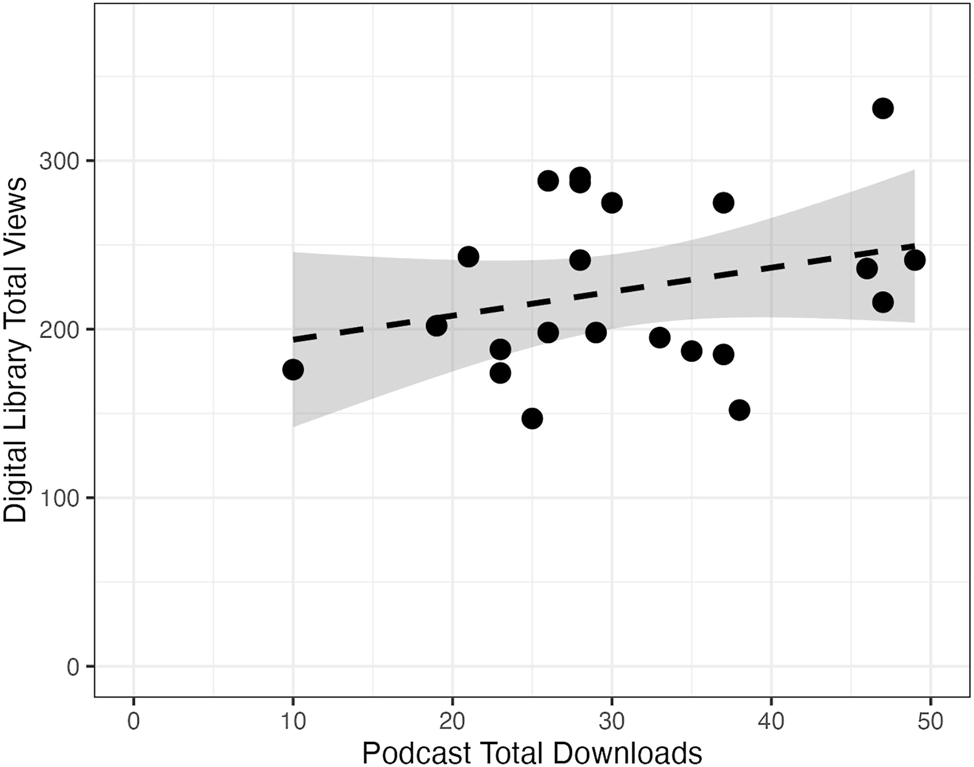
Chart of total digital library views compared to all-time podcast downloads for the RCOHP episodes (n = 22). The dashed line is the best fit linear regression, which models the relationship between the two variables being compared (i.e., digital library total views vs podcast total downloads). The shaded grey area represents the 95 % confidence interval of the linear regression.
Total digital library views separated by those with and without podcast episodes. Digital library collection abbreviations: ELC = Everett L. Cooley Oral History Project; GSL = Great Salt Lake Oral History Collection; RCOHP = Rock Climbing Oral History Project.
| Digital library collection (total items) | Corresponding podcast episode | Number of items | Digital library views | |
|---|---|---|---|---|
| Median (total) | Median (unique) | |||
| ELC (73) | False | 63 | 196 | 140 |
| True | 10 | 226 | 171 | |
| GSL (25) | False | 25 | 163 | 143 |
| RCOHP (31) | False | 9 | 160 | 147 |
| True | 22 | 209 | 174 | |
Given the overall slight increase in digital library views for items that were also released as a podcast, we examined the relationship between the number of podcast downloads and the number of Digital Library views for each item in the RCOHP collection (Figure 5). This comparison was limited to the RCOHP collection because they were uploaded to both platforms (podcast and Digital Library) in the same time period. There is a slight correlation between the number of podcast downloads and the number of digital library hits, although it did not reach statistical significance (Spearman’s correlation coefficient = 0.22, p = 0.32). This result suggests that increased podcast consumption may also increase the views of the corresponding digital library item, although additional datasets are needed to confirm this hypothesis.
4 Discussion
This is the first study to investigate and analyze the data from both a podcast and digital library collections. Regarding research question 1, these analyses demonstrate that people will listen to a podcast of unedited oral history audio files (Figures 1 and 2). For research question 2, an Ascent Archive episode increases the use of the corresponding digital library item (Figures 4 and 5). Although the increase in usage is not statistically significant at the time of this analysis, this slight correlation is promising as both the digital library collections and podcast will remain widely accessible for the foreseeable future. As additional longitudinal datasets are collected, these trends may become more pronounced or diminished over time. Moreover, the RCOHP collection and Ascent Archive were published in July 2023, so more time may be required to see statistical significance. For research question 3, a podcast of select oral histories does not appear to benefit the remainder of the collection in the digital library (Figure 3). Compared to the GSL, the RCOHP’s medium usage within the Digital Library is quite similar. Since Ascent Archive notes for each episode only linked to the corresponding digital library transcript, this may explain why the remainder of the RCOHP Digital Library collection did not receive additional views.
Previous literature and presentations about library or museum-created podcasts lack detailed data on their podcast analytics and do not analyze their collections’ usage. Rupinski and Rander (2019)‘s article about To the Letter discussed the desire for podcast statistics but did not report any since the WordPress blog and the iTunes Podcast Analytics they used were in beta. Smith et al (2020) included Libsyn podcast statistics of 3,593 downloads across 48 countries for Calling: Earth. Finally, Morales De Hendricks’ (2022) presentation on Stories from the Rio Grande shared more podcast analytics, specifically, 5,613 plays and 91 average listeners per episode. The top three platforms were Apple podcasts (56 %), Spotify (12 %), and Anchor (8 %) (Morales De Hendricks 2022). Consistent with the findings from this study, Apple podcasts appears to be the most popular method for podcast listening. A direct comparison to the Ascent Archive podcast is challenging since the time periods were not reported.
The Ascent Archive podcast is the first podcast to publish entire unedited oral history interviews. This was a conscious decision to ensure that the interviewees were not misrepresented by our editing or choice of oral history excerpts. This approach is further supported by Joshi Brekke’s (2020) critique of the “sonic whiteness” in podcasts as the top podcasts are generally created by white men and the podcast sounds and edits center on whiteness. In our informal scan of English-language climbing-related podcasts, the majority were hosted by white men. Both the RCOHP and Ascent Archive podcast creators critically considered what voices were elevated by these efforts. On the women-hosted Ascent Archive podcast, seventeen (51.5 %) out of the 33 rock climbers on the podcast are women and eight self-identify as BIPOC and/or queer[1] individuals (24.2 %). The Ascent Archive podcast has more representation than the Carter (2019) survey of Utah climbers that reported 64 % men, 93 % heterosexual/straight, and 90 % white.
The topic of outdoor recreation history, specifically rock climbing, is unique within the historical podcast realm. Most of the podcast literature that leveraged oral histories or archival materials focused on local histories or the World War II era (Bartolini 2022; Little 2022; Morales De Hendricks 2022; Rupinski and Rander 2019; Scriven 2022; Story 2022; Yoshida 2021). However, Ascent Archive covers local history topics beyond the sport of rock climbing. The importance of place resonates throughout both the Ascent Archive podcast and Scriven’s (2022) place-based podcast, Cork is the Lee. As one RCOHP interviewee observed about the RCOHP and Ascent Archive podcast, these are stories of human migration to Salt Lake City for rock climbing in Utah and Intermountain West.
There is a steady increase in digital library collection views in 2024 that appears consistent across the three oral history collections, with larger spikes in April and August (Figure 3). Given the increasing number of artificial intelligence (AI) large language models (LLMs) being developed, it’s worth considering if LLM training contributed to these digital library views. Massive amounts of data are required to train the LLM statistical models to “enhance their natural language understanding and natural language processing capabilities” (IBM 2023, n.p.). New data are necessary to continually increase LLMs’ ability to understand and generate text or other content (IBM 2023). However, AI LLMs also face challenges in locating high-quality training datasets as more websites block web crawlers and restrict their data for AI training (Roose 2024; Longpre et al. 2023). Longpre et al. (2023, 11) present these challenges for “non-profits, archives, and academic researchers” with regards to AI LLM consent and restrictions, however, they do not specify libraries or archives within their research findings. Robot exclusion protocols, website terms of service restrictions, anti-crawling, and now anti-AI restrictions are becoming more relevant for library websites and digital collections. Future research should determine if LLMs’ training data includes archival collections and the ethics surrounding this topic, especially for oral histories which contain personal stories and frequently imperfect transcripts.
Given the modest increase in the use of the digital library collection of oral histories in creating the podcast, it is worth considering the utility and practicality of a podcast. While producing a podcast can be time intensive (one to 3 h per episode), it provides a more dynamic outreach platform than a typical digital collection. When planning for a podcast project, ensuring adequate staffing for production is essential to the show’s longevity. In retrospect, a weekly podcast of entire oral histories was too frequent given the additional workload. Additionally, consistent marketing of the podcast is likely associated with new listeners and digital library usage.
This study is limited by challenges with website and user analytics. Although not reported due to privacy concerns, geographical location and IP data can be skewed by VPNs, web scraping tools, and user settings. Secondly, the usage analytics may be incomplete or inaccurate based on how Simplecast and the Digital Library “count” downloads and views. Simplecast does not report how much of an episode was completed (i.e. 10 minutes listened to versus the entire episode).
This is the first study to assess the impact of a library-created podcast and corresponding digital library collections. These statistical analyses evaluate the impact of our novel podcasting initiative and inform conversations about the allocation of digital library employee time and resources. The podcast did not significantly increase access to the entire oral history collections, however, a podcast episode slightly increased the use of the corresponding digital library item. User analytics should be re-examined in the future, especially for the newer RCOHP collection and Ascent Archive to evaluate longer-term impacts. This study demonstrates a new podcasting methodology and a more robust assessment approach for digital initiatives.
Acknowledgements
Special thanks to Danielle Rausch, Audiovisual Archivist, Leah Donaldson, web developer and graphic designer, Bryan E. Hull, colleague and musician, and the RCOHP Advisory Board members.
-
Data Sharing: The data that supports the findings of this study is available from the corresponding author, upon reasonable request.
References
Bartolini, B. 2022. “Queens Memory: Podcast and Public Engagement.” The Oral History Review 49 (1): 133–6. https://doi.org/10.1080/00940798.2022.2039010.Suche in Google Scholar
Bierman, J., and M. L. Valentino. 2011. “Podcasting Initiatives in American Research Libraries.” Library Hi Tech 29 (2): 349–58. https://doi.org/10.1108/07378831111138215.Suche in Google Scholar
Carter, D. P. 2019. “2019 Wasatch Climber Survey Summary Report.” Salt Lake Climbers Alliance. https://www.saltlakeclimbers.org/s/2019-SLCA-Survey-Results.pdf (accessed July 27, 2024).Suche in Google Scholar
De Sarkar, T. 2012. “Introducing Podcast in Library Service: An Analytical Study.” VINE 42 (2): 191–213. https://doi.org/10.1108/03055721211227237.Suche in Google Scholar
Drew, C. 2017. “Educational Podcasts: A Genre Analysis.” E-Learning and Digital Media 14 (4): 201–11. https://doi.org/10.1177/2042753017736177.Suche in Google Scholar
IBM. 2023. What are Large Language Models (LLMs)? IBM. https://www.ibm.com/think/topics/large-language-models (accessed April 3, 2025).Suche in Google Scholar
Joshi Brekke, A. 2020. “The Sound of Yellow Rain: Resisting Podcasting’s Sonic Whiteness.” In Radio’s Second Century, edited by John Allen Hendricks. Rutgers University Press.10.2307/j.ctvwcjfxv.15Suche in Google Scholar
J. Willard Marriott Library. n.d.a. Ascent Archive. J. Willard Marriott Library. https://ascentarchive.lib.utah.edu/ (accessed January 20, 2025).Suche in Google Scholar
J. Willard Marriott Library. n.d.b. Everett L. Cooley Oral History Project. Digital Library. https://collections.lib.utah.edu/search?facet_setname_s=uum_elc (accessed January 20, 2025).Suche in Google Scholar
J. Willard Marriott Library. n.d.c. Great Salt Lake Oral History Collection. Digital Library. https://collections.lib.utah.edu/search?facet_setname_s=uum_gslohc (accessed January 20, 2025).Suche in Google Scholar
J. Willard Marriott Library. n.d.d. Rock Climbers Oral History Project. Digital Library. https://collections.lib.utah.edu/search?facet_setname_s=uum_rcohp (accessed January 20, 2025).Suche in Google Scholar
Little, M. 2022. “Mississippi Moments. Podcast.” The Oral History Review 49 (1): 140–1. https://doi.org/10.1080/00940798.2022.2039014.Suche in Google Scholar
Longpre, S., R. Mahari, A. Chen, N. Obeng-Marnu, D. Sileo, W. Brannon, et al.. 2023. “The Data Provenance Initiative: A Large Scale Audit of Dataset Licensing & Attribution in AI.” arXiv. https://doi.org/10.48550/arXiv.2310.16787.Suche in Google Scholar
Mercier, L., and M. Buckendorf. 2010. Using Oral History in Community History Projects. Oral History Association.Suche in Google Scholar
Morales de Hendricks, P. 2022. Preserving History Through Podcasting: Sharing Community Stories. Texas Historical Commission, Museum Services Program. https://content.govdelivery.com/accounts/TXTHC/bulletins/31bf6fd (accessed July 27, 2024).Suche in Google Scholar
Roose, K. 2024. “The Data that Powers A.I. Is Disappearing Fast.” The New York Times. July 19, 2024, sec. Technology. https://www.nytimes.com/2024/07/19/technology/ai-data-restrictions.html (accessed January 20, 2025).Suche in Google Scholar
Rupinski, L., and J. Rander. 2019. “Telling Stories: A Case Study in Podcasting with Archival Resources.” Archival Issues 40 (1). https://doi.org/10.31274/archivalissues.11085.Suche in Google Scholar
Salt Lake Climbers Alliance. n.d. Little Cottonwood Canyon is Now a Historic Site. Salt Lake Climbers Alliance (blog). https://www.saltlakeclimbers.org/lcc-historic-climbing-area (accessed July 27, 2024).Suche in Google Scholar
Scriven, R. 2022. “Making a Podcast: Reflecting on Creating a Place‐based Podcast.” Area 54 (2): 260–7. https://doi.org/10.1111/area.12776.Suche in Google Scholar
Shearer, E., J. Liedke, K. E. Matsa, M. Lipkia, and M. Jurkowitz. 2023. Podcasts as a Source of News and Information. Pew Research Center (blog). https://www.pewresearch.org/journalism/2023/04/18/podcasts-as-a-source-of-news-and-information/ (accessed April 18, 2023).Suche in Google Scholar
Simplecast. n.d. Podcast Hosting, Distribution & Analytics – Simplecast. Simplecast. https://www.Simplecast.com (accessed April 18, 2023).Suche in Google Scholar
Smith, D., M. L. Cook, and M. Torrence. 2020. “Making Disciplinary Research Audible: The Academic Library as Podcaster.” Information Technology and Libraries 39 (3). https://doi.org/10.6017/ital.v39i3.12191.Suche in Google Scholar
Statista. 2024. Number of Podcast Listeners Worldwide 2024. Statista. https://www.statista.com/statistics/1291360/podcast-listeners-worldwide/ (accessed July 27, 2024).Suche in Google Scholar
Steele, A. 2024. A Few Blockbuster Podcasts Are Making All the Money. WSJ. https://www.wsj.com/business/media/a-few-blockbuster-podcasts-are-making-all-the-money-d9cee36e (accessed July 27, 2024).Suche in Google Scholar
Stocking, G., K. E. Matsa, S. Naseer, C. St. Aubin, E. Shearer, M. Jurkowitz, et al.. 2023. A Profile of the Top-Ranked Podcasts in the U.S. Pew Research Center (blog). https://www.pewresearch.org/journalism/2023/06/15/a-profile-of-the-top-ranked-podcasts-in-the-u-s/ (accessed June 15, 2023).Suche in Google Scholar
Story, D. 2022. “SONIC OPPORTUNITIES: Libraries and Podcasting.” Computers in Libraries 42 (4): 4–8.Suche in Google Scholar
Tait, G. B., and R. A. Schriner. 2022. “My Story, My Voice: Student Podcasts Examining Oral Histories on Diversity in East Central Indiana.” In Oral History and Qualitative Methodologies. Routledge.10.4324/9781003127192-17Suche in Google Scholar
Yoshida, H. 2021. “Campu: A Podcast. By Hana and Noah Maruyama. Seattle, WA: Densho: The Japanese.” The Oral History Review, July. https://www.tandfonline.com/doi/full/10.1080/00940798.2021.1953835 (accessed July 27, 2024).10.1080/00940798.2021.1953835Suche in Google Scholar
© 2025 the author(s), published by De Gruyter, Berlin/Boston
This work is licensed under the Creative Commons Attribution 4.0 International License.
Artikel in diesem Heft
- Frontmatter
- Editorial
- Technology, Preservation, and Resilience in an Era of Change: Editor’s Note
- Articles
- Newly Discovered Archival Logic: Functions Emerging from the Records in Contexts Standard
- Traversing Rock Climbers’ Oral Histories to Podcast Platforms: Processes, Analytics, and Digital Library Impact
- VGG-Based Feature Extraction for Classifying Traditional Batik Motifs Using Machine Learning Models
- The Impact of Artificial Intelligence on the Production and Editing of Audiovisual Content
- Navigation of Cultural Heritage in the Digital Age: The Role of Social Media Platforms in the Preservation of Selected Folk Performances of Odisha
- Review
- Saving Ukrainian Cultural Heritage Online (SUCHO)
- News and Comments
- PDT&C Editorial Board Position Paper on the Emerging Crisis in the Cultural Heritage and Preservation Sectors
Artikel in diesem Heft
- Frontmatter
- Editorial
- Technology, Preservation, and Resilience in an Era of Change: Editor’s Note
- Articles
- Newly Discovered Archival Logic: Functions Emerging from the Records in Contexts Standard
- Traversing Rock Climbers’ Oral Histories to Podcast Platforms: Processes, Analytics, and Digital Library Impact
- VGG-Based Feature Extraction for Classifying Traditional Batik Motifs Using Machine Learning Models
- The Impact of Artificial Intelligence on the Production and Editing of Audiovisual Content
- Navigation of Cultural Heritage in the Digital Age: The Role of Social Media Platforms in the Preservation of Selected Folk Performances of Odisha
- Review
- Saving Ukrainian Cultural Heritage Online (SUCHO)
- News and Comments
- PDT&C Editorial Board Position Paper on the Emerging Crisis in the Cultural Heritage and Preservation Sectors

